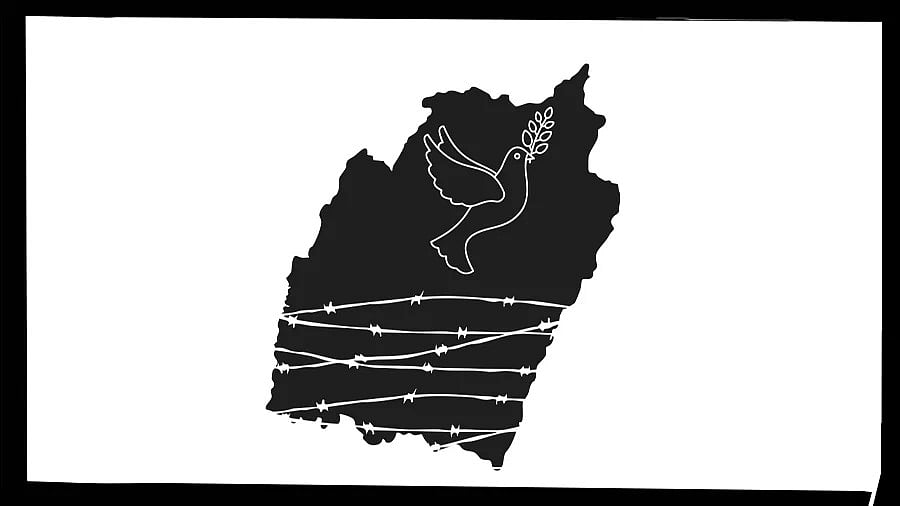
Emboldened by the imposition of President’s rule in February this year, the Manipur Police, which had hitherto been cautious about taking any legal action against members of the radical outfit - the Arambai Tenggol (AT) - has now adopted a more assertive approach, actively rounding up those who took law in their own hands.
On July 8, six AT members were arrested from two districts for assaulting Manipur police officials in Bishnupur on June 9. The Meiteis have been astir, demanding the release of the AT leader, Asem Kanan Singh, and even calling for a bandh on June 7.
Kanan Singh had been arrested by the CBI at Imphal airport over “his involvement in various criminal activities related to Manipur violence in 2023”. Twelve others who had been detained for questioning have been released. Kanan Singh was a head constable with the Manipur police, but was sacked for his alleged involvement in smuggling of arms.
Meitei group’s rise
The radical outfit, AT, raised in 2020 by Leishemba Sanajaoba, the scion of the erstwhile royal family of Manipur and presently a Rajya Sabha member, has been calling the shots in the state. One of the outfit’s main objectives is for Meiteis to revert to the native religion of Sanamahism - nature worship - which had been slowly replaced by Vaishnavism that rooted itself in Manipur in the later half of 18th century.
An AT spokesman, announcing the withdrawal of the 10-day bandh
call on June 10, said that the “group was formed as an unarmed socio-cultural organisation to preserve and promote the culture and traditions of Manipur. Circumstances forced us to take up arms”.
But during the mayhem that gripped the state from May 3, 2023, the AT, in collusion with other miscreants, looted weapons and ammunition from the armouries of police training schools, India Reserve Battalions, and police stations. Of the 5,600 arms and over 6.5 lakh rounds of ammunition looted, only 1,500 weapons and 20,000 rounds had been recovered by the police as of October 2023.
After the imposition of President’s rule, members of AT and other radical outfits surrendered hundreds of weapons. Simultaneous joint operations, carried out by the Central Armed Police Forces, Army, Assam Rifles and Manipur Police, in mid-June yielded 328 weapons, including SLRs, LMGs and carbines. On July 15, 86 more weapons, including AK Rifles, carbines and pistols, were recovered along with 974 live rounds. Still a large haul of arms and ammunition continue to be in the wrong hands.
With around 60,000 men on their rolls, armed cadres of the Arambai Tenggol, meaning “dart-wielding cavalry”, move around the valley sporting black T-shirts with AT insignia, threatening locals. The extent to which the AT has spread terror in the state can be gauged from the fact that on a call given by the outfit to all legislators, 37 MLAs and two MPs attended a rally in January last year in Kangla fort, in the heart of Imphal.
The MLAs were directed to submit their six demands to the Centre, which included expediting the NRC with 1951 as the cut-off date, abrogation of Suspension of Operations, better known as SoO, with the Kuki-Zo, withdrawal of Assam Rifles as they felt the para military forces was biased, removal of names of illegal migrants from
the Schedule Tribe list, complete fencing of Indo-Myanmar border and shifting of Myanmar refugees to neighbouring Mizoram.
Of these, the Centre has accepted the demand for fencing of the Manipur-Myanmar border, work for which has already begun. But there has been stiff opposition to the fencing by both Nagaland and Mizoram governments as they aver that the kin of people residing close to the border are related to those residing across the border, so much so that children from across the border attend schools in their part of the country and return home after school hours.
It is, therefore, no surprise that a large number of refugees from Myanmar have sought shelter in Mizoram due to the conflict raging between the ethnic groups and Myanmar’s Junta government. The Myanmar Air Force has even resorted to strafing hostile villages. These internecine clashes have, therefore, led to mass influx of Myanmarese to neighbouring Mizoram.
SoO pact
Meanwhile, the SoO tripartite agreement among the Centre, the Manipur government and the Kuki National Organisation, a conglomerate of 17 Kuki outfits, and the United People’s Front with eight other Kuki outfits under its umbrella, signed in 2008, has been periodically extended.
The SoO agreement with the Centre and the State which was being extended till 2023 is in a state of limbo since the Manipur government wanted the agreement to be terminated as there were allegations of their active participation in the ethnic conflict during the last two years, though the Kuki-Zo representatives assert that the former militants were all confined to their camps.
The talks between the Centre and the representatives of Kuki-Zo tribals that took place in New Delhi on June 9 and 16, has also hit a dead end. The Kuki-Zo representatives have been demanding Union Territory status with a legislature for the Kuki-Zo dominated districts. This is, however, being vehemently opposed by the Meiteis, who are resisting any bifurcation of the state.
It is time the concerned parties negotiate for peace in the north eastern state that has been periodically rocked by conflicts, impacting its development.
(The writer is a retired Inspector General of Police, CRPF)